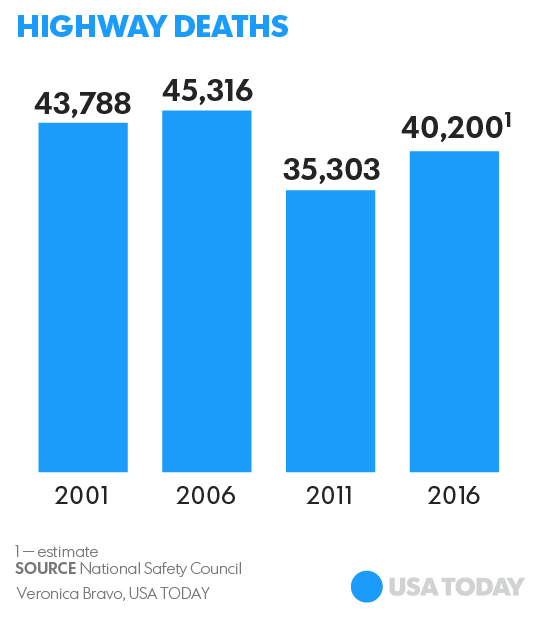Texting while driving hurts everyone: Our view
Traffic deaths spike after years of decline.
Even as cars have become safer and smarter than at any time in American history, traffic deaths have spiked in the past two years, reversing a general decline going back nearly a decade. Last year, 40,200 people died on the nation's roads, up about 14% from two years earlier, when 35,398 died.

The reasons are complex, some of them unavoidable. Economic recovery spurs more recreational driving that’s riskier as people go out on weekends and on vacation, driving on unfamiliar roads. More teenagers, who couldn’t afford to drive during the recession, are back behind the wheel.
Other causes are clearly avoidable. In the past three years, 13 states have raised their speed limits to 70 miles per hour and even 75 on some portion of their interstates. Even before this latest round of increases, researchers found that each 5 mile per hour increase in the maximum speed limit produces an 8% increase in fatalities on interstates and freeways.
Perhaps the most alarming factor is drivers who just can’t wait until they get out of the car to send or receive emails or texts. Take a nation with 228 million smartphones and 264 million vehicles, and you've got a toxic mix.
Some drivers assume that taking your eyes off the road for five seconds is no big deal. They're wrong. At 55 mph, that’s like driving the length of an entire football field blindfolded.
No texting-while-driving ban: Opposing view
Who in their right mind would do that? Well, in a survey last year by the AAA Foundation for Traffic Safety, 40% of drivers reported having read a text or an email while driving, and nearly a third reported typing one.
More bad news: Not only does this endanger everybody on the road, but everybody is paying more for insurance because of the foolish drivers who do it. According to the industry, the rise in wrecks is forcing an increase in rates, up 16% since 2011.
What to do? The solutions range from stricter enforcement to targeted technology.
Experiments in high-visibility police enforcement twinned with public service campaigns in Syracuse, N.Y., and Hartford, Conn., in 2011 showed a decline in texting, down a third in Syracuse and 72% in Hartford.
All but four states — Arizona, Missouri, Montana and Texas — ban texting while driving for all drivers. In Texas, where legislators have defeated proposed bans twice and former governor Rick Perry vetoed one in 2011, lawmakers plan to try again this year.
Opponents argue that there are enough laws to stop hazardous driving, and they see anti-texting laws as the long arm of government reaching into people's personal vehicles. That argument might make more sense if distracted drivers didn't also kill other innocent drivers and passengers.
Solutions will have to be found beyond new laws.
Just as public opinion has made drunken driving socially unacceptable, helping to cut deaths by more than half since 1980, public opinion could make texting and driving undesirable, too. Already, nearly 80% of drivers say texting or emailing while driving “is completely unacceptable.” The problem, of course, is what they say and what they do are totally different. Turning opinions into action won’t be easy in a nation of smartphone addicts.
Perhaps the best way to deal with a technology-caused problem is with technology-driven solutions. Self-driving cars, of course, would allow people to text as they please, but the nation faces a lengthy "how safe is safe enough" debate about these vehicles.
Shorter term, apps and devices already exist that can block calls (except to 911) or texts while a car is in motion. Instead of raising rates across the board, insurers could offer discounts for drivers who use these apps and devices.
The danger on the highways, and the urgency for action, will only increase as a new generation of drivers, part of the smartphone generation, gets behind the wheel.
USA TODAY's editorial opinions are decided by its Editorial Board, separate from the news staff. Most editorials are coupled with an opposing view — a unique USA TODAY feature.
To read more editorials, go to the Opinion front page or sign up for the daily Opinion email newsletter. To respond to this editorial, submit a comment to letters@usatoday.com.
